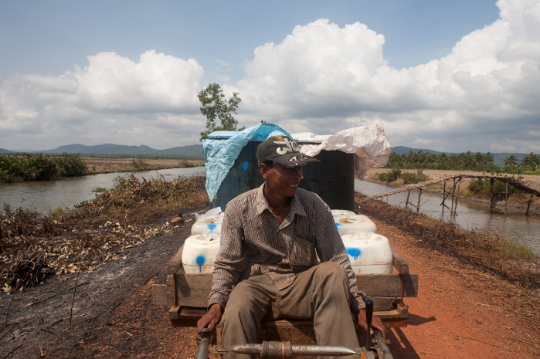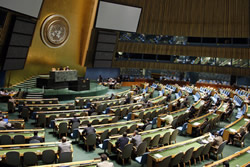2011 Human Development Index: Norway at top, DR Congo last
2011 Human Development Index: Norway at top, DR Congo last
02 November 2011
Copenhagen—Norway, Australia and the Netherlands lead the world in the 2011 Human Development Index (HDI), while the Democratic Republic of the Congo, Niger and Burundi are at the bottom of the Human Development Report’s annual rankings of national achievement in health, education and income, released today by the United Nations Development Programme (UNDP).
 (PHOTO: ©UNDP/ARANTXA CEDILLO)
(PHOTO: ©UNDP/ARANTXA CEDILLO)
Index covers record 187 countries and territories; inequalities lower HDI rankings for US, Republic of Korea, others
The United States, New Zealand, Canada, Ireland, Liechtenstein, Germany and Sweden round out the top 10 countries in the 2011 HDI, but when the Index is adjusted for internal inequalities in health, education and income, some of the wealthiest nations drop out of the HDI’s top 20: the United States falls from #4 to #23, the Republic of Korea from #15 to #32, and Israel from #17 to #25.
The United States and Israel drop in the Report’s Inequality-adjusted HDI (IHDI) mainly because of income inequality, though health care is also a factor in the US ranking change, while wide education gaps between generations detract from the Republic of Korea’s IHDI performance.
Other top national achievers rise in the IHDI due to greater relative internal equalities in health, education and income: Sweden jumps from #10 to #5, Denmark climbs from #16 to #12, and Slovenia rises from #21 to #14.
The IHDI and two other composite indices—the Multidimensional Poverty Index and the Gender Inequality Index—were designed to complement the Human Development Report’s HDI, which is based on national averages in schooling, life expectancy, and per capita income. The 2011 HDI covers a record 187 countries and territories, up from 169 in 2010, reflecting in part improved data availability for many small island states of the Caribbean and the Pacific. The 2011 country rankings are therefore not comparable to the 2010 Report’s HDI figures, the authors note.
“The Inequality-adjusted Human Development Index helps us assess better the levels of development for all segments of society, rather than for just the mythical ‘average’ person,” said Milorad Kovacevic, chief statistician for the Human Development Report. “We consider health and education distribution to be just as important in this equation as income, and the data show great inequities in many countries.”
The 2011 Report—Sustainability and Equity: A Better Future for All—notes that income distribution has worsened in most of the world, with Latin America remaining the most unequal region in income terms, even though several countries including Brazil and Chile are narrowing internal income gaps. Yet in overall IHDI terms, including life expectancy and schooling, Latin America is more equitable than sub-Saharan Africa or South Asia, the Report shows.
To assess income distribution, as well as varying levels of life expectancy and schooling within national populations, the IHDI uses methodology developed by the renowned British economist Sir Anthony Barnes Atkinson. “We use the Atkinson approach to measure inequalities in health, education and income, because it is more sensitive to changes at the lower end of the scale than the more familiar Gini coefficient,” Kovacevic said.
Average HDI levels have risen greatly since 1970—41 percent globally and 61 percent in today’s low-HDI countries—reflecting major overall gains in health, education and income. The 2011 HDI charts progress over five years to show recent national trends: 72 nations moved up in rank from 2006 to 2011, led by Cuba (+10 to #51), Venezuela and Tanzania (+7 each to #73 and #152, respectively), while another 72 fell in rank, including
Kuwait (-8 to #63) and Finland (-7 to #22).
The 10 countries that place last in the 2011 HDI are all in sub-Saharan Africa: Guinea, Central African Republic, Sierra Leone, Burkina Faso, Liberia, Chad, Mozambique, Burundi, Niger, and the Democratic Republic of
the Congo.
Despite recent progress, these low-HDI nations still suffer from inadequate incomes, limited schooling opportunities, and life expectancies far below world averages due in great part to deaths from preventable and treatable diseases such as malaria and AIDS. In many, these problems are compounded by the destructive legacy of armed conflict. In the lowest-ranking country in the 2011 HDI, the Democratic Republic of
the Congo, more than three million people died from warfare and conflict-linked illness in recent years, prompting the largest peacekeeping operation in UN history.
Gender Inequality Index
The Gender Inequality Index (GII) shows that Sweden leads the world in gender equality, as measured by this composite index of reproduce-tive health, years of schooling, parliamentary representation, and participation in the labour market. Sweden is followed in the gender inequality rankings by the Netherlands, Denmark, Switzerland, Finland, Norway, Germany, Singapore, Iceland and France.
Yemen ranks as the least equitable of the 146 countries in the GII, followed by Chad, Niger, Mali, Democratic Republic of the Congo, Afghanistan, Papua New Guinea, Liberia, Central African Republic and Sierra Leone. In Yemen, just 7.6 percent of women have a secondary education, compared to 24.4 percent for men; women hold
just 0.7 percent of seats in the legislature; and only 20 percent of working-age women are in the paid work force, compared to 74 percent of men.
“In sub-Saharan Africa the biggest losses arise from gender disparities in education and from high maternal mortality and adolescent fertility rates,” the Report’s authors write. “In South Asia, women lag behind men in each dimension of the GII, most notably in education, national parliamentary representation and labour force participation. Women in Arab states are affected by unequal labour force participation (around half the global average) and low educational attainment.”
Multidimensional Poverty Index
The Multidimensional Poverty Index (MPI) examines factors at the family level—such as access to clean water and cooking fuel and health services, as well as basic household goods and home construction standards—that together provide a fuller portrait of poverty than income measurements alone.
Some 1.7 billion people in 109 countries lived in ‘multidimensional’ poverty in the decade ending in 2010, by the MPI calculus, or almost a third of the countries’ entire combined population of 5.5 billion. That compares to the
1.3 billion people estimated to live on US$1.25 a day or less, the measure used in the UN Millennium Development Goals, which seeks to eradicate “extreme” poverty by 2015.
Niger has the highest share of multidimensionally poor, at 92 percent of the population, the Report says, followed by Ethiopia and Mali, with 89 percent and 87 percent, respectively. The 10 poorest nations as measured by the MPI are all in sub-Saharan Africa. But the largest group of multidimensionally poor is South Asian: India, Pakistan and Bangladesh have some of the highest absolute numbers of MPI poor.
The MPI provides insight into environmental problems in the poorest households, including indoor air pollution and disease from contaminated water supplies. The Report notes that in South Asia and sub-Saharan Africa, more than 90 percent of the multidimensionally poor cannot afford clean cooking fuel, relying principally on firewood, while some 85 percent lack basic sanitation services.
ABOUT THE Human Development Index (HDI): The HDI has been published annually since the first Human Development Report in 1990 as an alternative measurement of national development, challenging purely economic assessments of progress such as Gross Domestic Product. HDI rankings are recalculated annually using the latest internationally comparable data for health, education and income. The Inequality adjusted HDI (IHDI) was introduced along with the Gender Inequality Index (GII) and Multidimensional Poverty Index (MPI) in last year’s Human Development Report to complement the original HDI, which as a composite measure of national averages does not reflect internal inequalities. Due to data limitations these composite indexes do not gauge other factors considered equally essential elements of human development, such as civic engagement, environmental sustainability or the quality of education and health standards.
ABOUT THIS REPORT: The annual Human Development Report is an editorially independent publication of the United Nations Development Programme. For free downloads of the 2011 Human Development Report in ten languages, plus additional reference materials on its indices and specific regional implications, please visit: http://hdr.undp.org.
ABOUT UNDP: UNDP partners with people at all levels of society to help build nations that can withstand crisis, and drive and sustain the kind of growth that improves the quality of life for everyone. On the ground in 177 countries and territories, we offer global perspective and local insight to help empower lives and build resilient nations. Please visit: www.undp.org
###
> United Nations (UN).
 The United Nations was established on 24 October 1945 by 51 countries committed to preserving peace through international cooperation and collective security. Today, nearly every nation in the world belongs to the UN: membership totals 192 countries.
The United Nations was established on 24 October 1945 by 51 countries committed to preserving peace through international cooperation and collective security. Today, nearly every nation in the world belongs to the UN: membership totals 192 countries.
When States become Members of the United Nations, they agree to accept the obligations of the UN Charter, an international treaty that sets out basic principles of international relations. According to the Charter, the UN has four purposes:
- to maintain international peace and security;
- to develop friendly relations among nations;
- to cooperate in solving international problems and in promoting respect for human rights;
- and to be a centre for harmonizing the actions of nations.
###
* The above story is adapted from materials provided by United Nations (UN)
** More information at United Nations (UN)




















